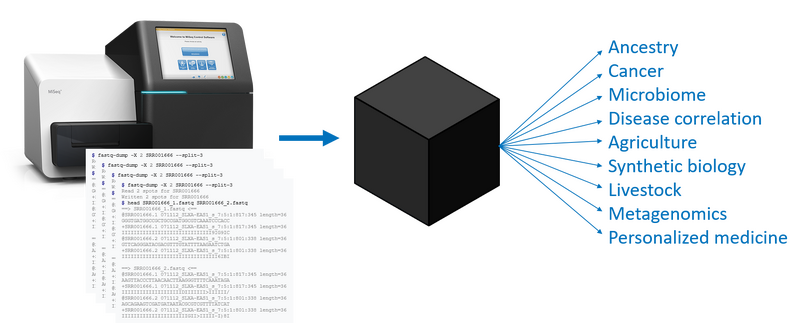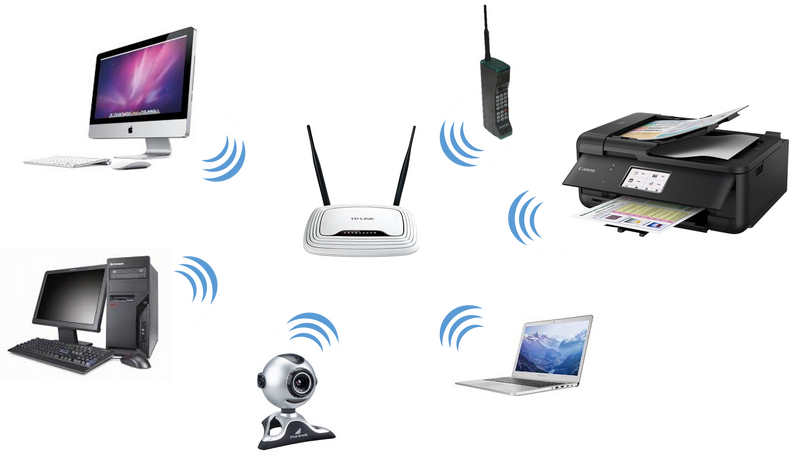About: Difference between revisions
| Line 6: | Line 6: | ||
A BioCompute Object (BCO) is an instance of the BioCompute standard, and is a computational record of a bioinformatics pipeline. A BCO is not an analysis, but is a record of which analyses were executed and in exactly which ways. In this way, a BCO acts as an interface for existing standards. A BCO contains all of the necessary information to repeat an entire pipeline from FASTQ to result, and includes additional metadata to identify provenance and usage. | A BioCompute Object (BCO) is an instance of the BioCompute standard, and is a computational record of a bioinformatics pipeline. A BCO is not an analysis, but is a record of which analyses were executed and in exactly which ways. In this way, a BCO acts as an interface for existing standards. A BCO contains all of the necessary information to repeat an entire pipeline from FASTQ to result, and includes additional metadata to identify provenance and usage. | ||
[[File:About.3.png| | [[File:About.3.png|800px|thumb|center]] | ||
A BioCompute Object (BCO) is an instance of the BioCompute standard, and is a computational record of a bioinformatics pipeline. A BCO is not an analysis, but is a record of which analyses were executed and in exactly which ways. In this way, a BCO acts as an interface for existing standards. A BCO contains all of the necessary information to repeat an entire pipeline from FASTQ to result, and includes additional metadata to identify provenance and usage. | |||
== WiFi Analogy == | |||
The [https://en.wikipedia.org/wiki/IEEE%20802.11 802.11 standard] (more commonly called “WiFi”) is a way of standardizing communication between vastly different products on a wireless network. If a product manufacturer wants a product to be able to communicate on a wireless internet network, they can configure the device to use the WiFi standard and it will be able to communicate with most commercial routers, regardless of whether the product is a Mac, a PC, a cell phone, or a smart toaster. | |||
[[File:Wifi analogy.png|800px|thumb|center]] | |||
BioCompute fills a similar need. BioCompute is not an automation or a new programming language, it is a way of collecting and communicating information between two entities. Rather than a latop and a router, it may be between a pharmaceutical company and the FDA, or between two clinicians, or between a clinician and a researcher. In much the same way that WiFi does not standardize the data that’s being transmitted – allowing you to use Apple’s Facetime, Microsoft’s Internet Explorer, or your favorite cell phone app – BioCompute does not standardize the platforms or tools that are used for genome analysis. You continue to use your favorite platforms and tools, whether it’s [https://hive.biochemistry.gwu.edu/dna.cgi?cmd=main HIVE], [https://galaxyproject.org/ Galaxy], [https://www.sevenbridges.com/ Seven Bridges], [https://www.dnanexus.com/ DNAnexus], or others. Also like WiFi, BioCompute can be layered with other privacy or security protocols depending on usage. So clinical trial data can be secured and HIPAA-compliant, while government-funded data sets shared between researchers can be completely open access. | |||
Because BioCompute acts like an envelope for an entire analysis pipeline, it is compatible with other existing standards, including [https://www.hl7.org/fhir/genomics.html FHIR Genomics] and [https://www.ga4gh.org/ GA4GH]. | |||
Revision as of 15:49, 5 August 2022
What is BioCompute?
Tremendous insights can be found in genome data, and many of these insights are being used to drive personalized medicine. But the hundreds of millions of reads that come from a gene sequencer represent small, nearly random fragments of the genome that’s being sequenced, and there are countless ways in which that data can be transformed to yield insights into cancer, ancestry, microbiome dynamics, metagenomics, and many other areas of interest.
Because there are so many different platforms and so many different scripts and tools to analyze genome data, there is a great need to standardize the way in which these steps are communicated. The more analysis steps and the more complicated a pipeline, the greater the need for a standardized mechanism of communication. The BioCompute standard brings clarity to an analysis, making it clear and reproducible.
A BioCompute Object (BCO) is an instance of the BioCompute standard, and is a computational record of a bioinformatics pipeline. A BCO is not an analysis, but is a record of which analyses were executed and in exactly which ways. In this way, a BCO acts as an interface for existing standards. A BCO contains all of the necessary information to repeat an entire pipeline from FASTQ to result, and includes additional metadata to identify provenance and usage.
A BioCompute Object (BCO) is an instance of the BioCompute standard, and is a computational record of a bioinformatics pipeline. A BCO is not an analysis, but is a record of which analyses were executed and in exactly which ways. In this way, a BCO acts as an interface for existing standards. A BCO contains all of the necessary information to repeat an entire pipeline from FASTQ to result, and includes additional metadata to identify provenance and usage.
WiFi Analogy
The 802.11 standard (more commonly called “WiFi”) is a way of standardizing communication between vastly different products on a wireless network. If a product manufacturer wants a product to be able to communicate on a wireless internet network, they can configure the device to use the WiFi standard and it will be able to communicate with most commercial routers, regardless of whether the product is a Mac, a PC, a cell phone, or a smart toaster.
BioCompute fills a similar need. BioCompute is not an automation or a new programming language, it is a way of collecting and communicating information between two entities. Rather than a latop and a router, it may be between a pharmaceutical company and the FDA, or between two clinicians, or between a clinician and a researcher. In much the same way that WiFi does not standardize the data that’s being transmitted – allowing you to use Apple’s Facetime, Microsoft’s Internet Explorer, or your favorite cell phone app – BioCompute does not standardize the platforms or tools that are used for genome analysis. You continue to use your favorite platforms and tools, whether it’s HIVE, Galaxy, Seven Bridges, DNAnexus, or others. Also like WiFi, BioCompute can be layered with other privacy or security protocols depending on usage. So clinical trial data can be secured and HIPAA-compliant, while government-funded data sets shared between researchers can be completely open access.
Because BioCompute acts like an envelope for an entire analysis pipeline, it is compatible with other existing standards, including FHIR Genomics and GA4GH.

